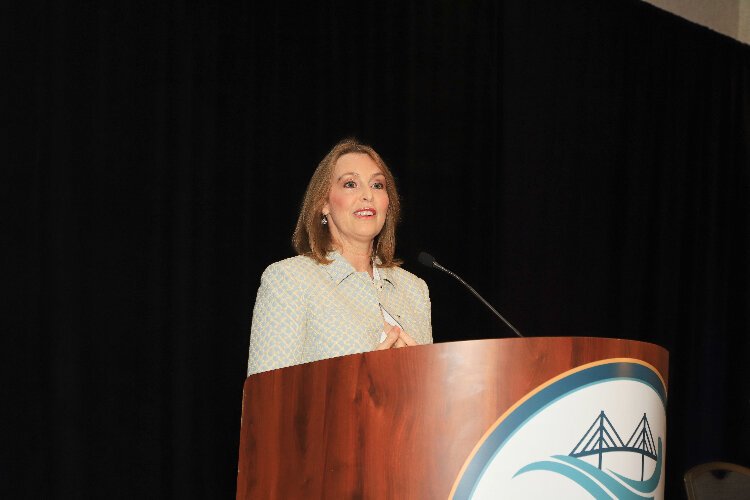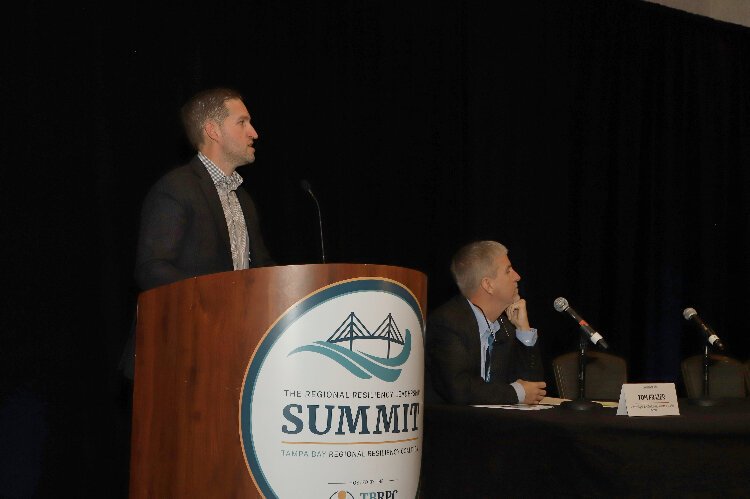Tampa Bay leaders talk resiliency strategies as hurricane season approaches
With the 2023 hurricane season looming, leaders from across the Tampa Bay region meet to discuss resiliency strategies and programs.
With the start of the Atlantic hurricane season looming June 1st, leaders from across the Tampa Bay region gathered for a two-day conference on resiliency strategies to respond to climate change and sea-level rise.
As the 2023 season nears, the destruction Hurricane Ian wreaked across Southwest Florida last year was a point of concern running through the third annual Tampa Bay Regional Resiliency Leadership Summit, which the Tampa Bay Regional Planning Council put on May 4th and 5th at the Hilton Clearwater Beach. Originally forecast to hit Tampa Bay, Ian made landfall as a category 4 in Southwest Florida, causing nearly $113 billion in property damage and taking the lives of 66 people.
At the summit, U.S. Congresswoman Kathy Castor, of Tampa, recalled visiting Southwest Florida after Ian to see the devastation firsthand. Flying in, she got a bird’s eye view of the widespread destruction from the storm surge and flooding, as well as massive dark patches of water from the nutrients and other pollutants washed into the Gulf of Mexico and the Peace River.
“I took that back to Washington D.C. with a newfound determination to see that our community has the tools and resources it needs to be as resilient as possible,” Castor says.
Federal and state funding flowing to Tampa Bay
Castor, the former chair of the Select Committee on the Climate Crisis, says the bipartisan infrastructure bill passed in late 2021 and the Inflation Reduction Act passed along party lines in 2022 offer significant funding for local governments’ resiliency efforts. In April, the Biden administration announced $78.7 million in grants to Florida through the Climate-Ready Coasts initiative funded by those two pieces of legislation.
The Tampa Bay region is part of a $4.9 million oyster reef habitat restoration project that will stretch along the west coast of Florida to Alabama, Louisiana and Texas. Through it, oyster shells will be collected from restaurants, recycled and put back into the water at oyster reef restoration sites, protecting shorelines and improving water quality.
Another $2.25 million will go toward a Pinellas County government project in partnership with Keep Pinellas Beautiful and the Tampa Bay Estuary Program to remove more than 200,000 tires from Tampa Bay and the Gulf that were placed in the water from the 1960s to 1980s as artificial reefs.
While a large portion of the money for those projects is from the infrastructure bill, Castor feels the Inflation Reduction Act is the potential game-changer and “probably the most impactful climate law ever passed worldwide.” Its funding, programs and incentives to transition to a clean energy economy include a 30 percent cash-back rebate program for eligible projects. In this area, Castor says those projects could include the solar panel installation at Tampa’s City Center at Hanna municipal complex and community center, which is now under construction in East Tampa, and the solar array at regional food bank charity Feeding Tampa Bay’s new headquarters, which is also currently under construction.
Castor says to tap more of the significant funding opportunities available in the Inflation Reduction Act, Florida’s state government needs to do more to promote clean energy and energy efficiency initiatives that reduce greenhouse gases.
During his presentation, Florida Chief Resilience Officer Wesley Brooks says nearly $97 million in state and local funds have gone into resilience projects in the Tampa Bay region in recent years. They include planning initiatives, vulnerability assessments upgrades to wastewater systems, drainage improvements to reduce flooding and living shoreline projects to protect against storm surge. Brooks expects the 2023-24 budget will put another $51.2 million in state funds toward resiliency efforts in Tampa Bay, with local matches pushing the total annual investment for the region above $101 million.
While the investments are numerous and significant, much more has to be done. A 2022 report from the Tampa Bay Partnership says more than $13 billion has to be invested in the Tampa Bay region over the next 25 years to protect against sea level rise and flooding. Elevating homes, other buildings and roadways, green infrastructure, utility and stormwater improvements and infrastructure such as seawalls, pumps, baffle boxes and tidal gates to defend dry land from flooding and tidal intrusion are all among the improvements experts say the region will need.
Impact on the economy and businesses
Pinellas County Economic Development Director Cynthia Johnson says conversations with business owners before and after Ian and Tropical Strom Nicole raised concerns about a lack of preparation.
“There really is a culture of complacency because Tampa Bay has avoided a big hit from a major hurricane,” she says.
Johnson says many business owners were not up to speed on the documentation to get assistance from the Federal Emergency Management Agency or the Small Business Administration after a hurricane.
A panel discussion including Johnson, Tampa Bay Partnership President and Chief Executive Officer Bemetra Simmons, St. Pete Innovation District Executive Director Alison Barlow and Tampa Bay Innovation Center President & CEO Tonya Elmore also delves into the innovative economic development and business responses to climate change and sea level rise.
Barlow notes that the Ocean Team, a consortium of researchers, businesses, government agencies and nonprofits in the St. Pete Innovation District, is testing new seawall technology designed to better absorb and dissipate the energy of waves. Saildrone, which has offices in the innovation district, has also launched its uncrewed vehicles into storms to collect and report data.
The Tampa Bay Innovation Center has also launched an accelerator program for climate tech startups, with more than 250 companies applying. Among other areas, the eight companies selected for that first cohort are working on innovations to monitor or reduce greenhouse gas emissions, generate more sustainable energy sources and reduce waste that currently ends up in landfills or waterways.
Adding to the affordability crisis
Florida’s development and population boom has already pushed up housing costs, leading to a crisis of affordability for many homeowners and prospective buyers. A panel discussion notes that extreme weather events and sea-level rise have added another contributing factor to those affordability struggles- property insurance. Many homeowners either cannot afford home insurance or can only afford a bare-bones plan. On top of that, flood insurance is now required in many areas.
Programs such as My Safe Florida Home help homeowners pay for upgrades to protect their primary residence against a hurricane, increasing their chances of getting insurance at an affordable rate. But St. Petersburg City Council Chair Brandi Gabbard, a real estate broker who represents a district almost completely in a FEMA-designated coastal high-hazard area, says the work to find solutions for the insurance crisis has to expand.
“This is our current and next affordability crisis,” Gabbard says.
For more information, go to Resiliency planning.















